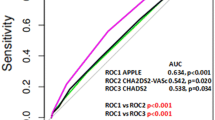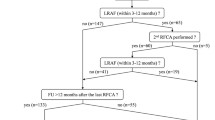Abstract
Background
Several clinical risk factors and scoring systems have been proposed to predict arrhythmia recurrence after atrial fibrillation (AF) ablation. We sought to determine the ability of a new score to predict atrial arrhythmia recurrence after cryoballoon (CB) ablation of AF and whether the new score shows superior efficiency compared to previously offered scores.
Methods
A total of 419 patients with paroxysmal AF who underwent their first CB ablation were included. Baseline clinical variables were analyzed, and independent predictors of recurrence at 12 months were used to develop the PAT2C2H score. The predictive capability of the new score was calculated and compared with the currently available risk scores.
Results
Chronic obstructive pulmonary disease, left atrial dilatation, transient ischemic attack or stroke, congestive heart failure, and hypertension were independent predictors of recurrence. The PAT2C2H score which was developed from these variables had a better clinical predictive capability of arrhythmia recurrence compared to HATCH and CHA2DS2-VASc scores. With increasing PAT2C2H score and score severity (low, score of 0; moderate, score of 1–2; and high, score of ≥ 3), the proportion of patients with recurrence was increased from 7% (score = 0, severity = low) to 59% (score ≥ 3, severity = high).
Conclusions
The PAT2C2H score may help to identify patients who are likely benefited most from CB ablation of paroxysmal AF and who should be monitored more closely for arrhythmia recurrence at 12 months.




Similar content being viewed by others
References
January CT, Wann LS, Alpert JS, Calkins H, Cigarroa JE, Cleveland JC Jr, et al. 2014 AHA/ACC/HRS guideline for the management of patients with atrial fibrillation: a report of the American College of Cardiology/American Heart Association Task Force on Practice Guidelines and the Heart Rhythm Society. J Am Coll Cardiol. 2014;64:e1-76. https://doi.org/10.1016/j.jacc.2014.03.022.
Hindricks G, Potpara T, Dagres N, Arbelo E, Bax JJ, Blomstrom-Lundqvist C, et al. 2020 ESC Guidelines for the diagnosis and management of atrial fibrillation developed in collaboration with the European Association for Cardio-Thoracic Surgery (EACTS): The Task Force for the diagnosis and management of atrial fibrillation of the European Society of Cardiology (ESC) Developed with the special contribution of the European Heart Rhythm Association (EHRA) of the ESC. Eur Heart J. 2021;42:373–498. https://doi.org/10.1093/eurheartj/ehaa612.
Aytemir K, Gurses KM, Yalcin MU, Kocyigit D, Dural M, Evranos B, et al. Safety and efficacy outcomes in patients undergoing pulmonary vein isolation with second-generation cryoballoondagger. Europace. 2015;17:379–87. https://doi.org/10.1093/europace/euu273.
Andrade JG, Champagne J, Dubuc M, Deyell MW, Verma A, Macle L, et al. Cryoballoon or radiofrequency ablation for atrial fibrillation assessed by continuous monitoring: a randomized clinical trial. Circulation. 2019;140:1779–88. https://doi.org/10.1161/CIRCULATIONAHA.119.042622.
Andrade JG, Wells GA, Deyell MW, Bennett M, Essebag V, Champagne J, et al. Cryoablation or drug therapy for initial treatment of atrial fibrillation. N Engl J Med. 2021;384:305–15. https://doi.org/10.1056/NEJMoa2029980.
Gu J, Liu X, Tan H, Zhou L, Jiang W, Wang Y, et al. Impact of chronic obstructive pulmonary disease on procedural outcomes and quality of life in patients with atrial fibrillation undergoing catheter ablation. J Cardiovasc Electrophysiol. 2013;24:148–54. https://doi.org/10.1111/j.1540-8167.2012.02448.x.
D’Ascenzo F, Corleto A, Biondi-Zoccai G, Anselmino M, Ferraris F, di Biase L, et al. Which are the most reliable predictors of recurrence of atrial fibrillation after transcatheter ablation?: a meta-analysis. Int J Cardiol. 2013;167:1984–9. https://doi.org/10.1016/j.ijcard.2012.05.008.
Bavishi AA, Kaplan RM, Peigh G, Diaz CL, Baman JR, Trivedi A, et al. Patient characteristics as predictors of recurrence of atrial fibrillation following cryoballoon ablation. Pacing Clin Electrophysiol. 2019;42:694–704. https://doi.org/10.1111/pace.13669.
Arora S, Lahewala S, Tripathi B, Mehta V, Kumar V, Chandramohan D, et al. Causes and predictors of readmission in patients with atrial fibrillation undergoing catheter ablation: a national population-based cohort study. J Am Heart Assoc. 2018;7. https://doi.org/10.1161/JAHA.118.009294
Mulder MJ, Kemme MJB, Hopman L, Kusgozoglu E, Gulcicek H, van de Ven PM, et al. Comparison of the predictive value of ten risk scores for outcomes of atrial fibrillation patients undergoing radiofrequency pulmonary vein isolation. Int J Cardiol. 2021;344:103–10. https://doi.org/10.1016/j.ijcard.2021.09.029.
Letsas KP, Efremidis M, Giannopoulos G, Deftereos S, Lioni L, Korantzopoulos P, et al. CHADS2 and CHA2DS2-VASc scores as predictors of left atrial ablation outcomes for paroxysmal atrial fibrillation. Europace. 2014;16:202–7. https://doi.org/10.1093/europace/eut210.
Saliba W, Gronich N, Barnett-Griness O, Rennert G. Usefulness of CHADS2 and CHA2DS2-VASc scores in the prediction of new-onset atrial fibrillation: a population-based study. Am J Med. 2016;129:843–9. https://doi.org/10.1016/j.amjmed.2016.02.029.
Jacobs V, May HT, Bair TL, Crandall BG, Cutler M, Day JD, et al. The impact of risk score (CHADS2 versus CHA2DS2-VASc) on long-term outcomes after atrial fibrillation ablation. Heart Rhythm. 2015;12:681–6. https://doi.org/10.1016/j.hrthm.2014.12.034.
Wazni OM, Dandamudi G, Sood N, Hoyt R, Tyler J, Durrani S, et al. Cryoballoon ablation as initial therapy for atrial fibrillation. N Engl J Med. 2021;384:316–24. https://doi.org/10.1056/NEJMoa2029554.
Kuniss M, Pavlovic N, Velagic V, Hermida JS, Healey S, Arena G, et al. Cryoballoon ablation vs. antiarrhythmic drugs: first-line therapy for patients with paroxysmal atrial fibrillation. Europace. 2021;23:1033–41. https://doi.org/10.1093/europace/euab029.
Balk EM, Garlitski AC, Alsheikh-Ali AA, Terasawa T, Chung M, Ip S. Predictors of atrial fibrillation recurrence after radiofrequency catheter ablation: a systematic review. J Cardiovasc Electrophysiol. 2010;21:1208–16. https://doi.org/10.1111/j.1540-8167.2010.01798.x.
Himmelreich JCL, Veelers L, Lucassen WAM, Schnabel RB, Rienstra M, van Weert H, et al. Prediction models for atrial fibrillation applicable in the community: a systematic review and meta-analysis. Europace. 2020;22:684–94. https://doi.org/10.1093/europace/euaa005.
Li YG, Pastori D, Farcomeni A, Yang PS, Jang E, Joung B, et al. A simple clinical risk score (C2HEST) for predicting incident atrial fibrillation in asian subjects: derivation in 471,446 Chinese subjects, with internal validation and external application in 451,199 Korean Subjects. Chest. 2019;155:510–8. https://doi.org/10.1016/j.chest.2018.09.011.
de Vos CB, Pisters R, Nieuwlaat R, Prins MH, Tieleman RG, Coelen RJ, et al. Progression from paroxysmal to persistent atrial fibrillation clinical correlates and prognosis. J Am Coll Cardiol. 2010;55:725–31. https://doi.org/10.1016/j.jacc.2009.11.040.
Hu WS, Lin CL. Prediction of new-onset atrial fibrillation for general population in Asia: a comparison of C2HEST and HATCH scores. Int J Cardiol. 2020;313:60–3. https://doi.org/10.1016/j.ijcard.2020.03.036.
Kornej J, Hindricks G, Kosiuk J, Arya A, Sommer P, Husser D, et al. Comparison of CHADS2, R2CHADS2, and CHA2DS2-VASc scores for the prediction of rhythm outcomes after catheter ablation of atrial fibrillation: the Leipzig Heart Center AF Ablation Registry. Circ Arrhythm Electrophysiol. 2014;7:281–7. https://doi.org/10.1161/CIRCEP.113.001182.
Furnkranz A, Chun KR, Nuyens D, Metzner A, Koster I, Schmidt B, et al. Characterization of conduction recovery after pulmonary vein isolation using the “single big cryoballoon” technique. Heart Rhythm. 2010;7:184–90. https://doi.org/10.1016/j.hrthm.2009.10.038.
Eckstein J, Verheule S, de Groot NM, Allessie M, Schotten U. Mechanisms of perpetuation of atrial fibrillation in chronically dilated atria. Prog Biophys Mol Biol. 2008;97:435–51. https://doi.org/10.1016/j.pbiomolbio.2008.02.019.
Calkins H, Gache L, Frame D, Boo LM, Ghaly N, Schilling R, et al. Predictive value of atrial fibrillation during the postradiofrequency ablation blanking period. Heart Rhythm. 2021;18:366–73. https://doi.org/10.1016/j.hrthm.2020.11.020.
Author information
Authors and Affiliations
Corresponding author
Ethics declarations
Ethical approval
The study was approved by the institutional ethics committee.
Informed consent
Informed consent was waived due to retrospective nature of the study.
Conflict of interest
The authors declare no competing interests.
Additional information
Publisher's note
Springer Nature remains neutral with regard to jurisdictional claims in published maps and institutional affiliations.
Supplementary Information
Below is the link to the electronic supplementary material.


Rights and permissions
Springer Nature or its licensor holds exclusive rights to this article under a publishing agreement with the author(s) or other rightsholder(s); author self-archiving of the accepted manuscript version of this article is solely governed by the terms of such publishing agreement and applicable law.
About this article
Cite this article
Cay, S., Kara, M., Ozcan, F. et al. A new scoring system: PAT2C2H score. Its clinical use and comparison with HATCH and CHA2DS2-VASc scores in predicting arrhythmia recurrence after cryoballoon ablation of paroxysmal atrial fibrillation. J Interv Card Electrophysiol 65, 701–710 (2022). https://doi.org/10.1007/s10840-022-01328-4
Received:
Accepted:
Published:
Issue Date:
DOI: https://doi.org/10.1007/s10840-022-01328-4




